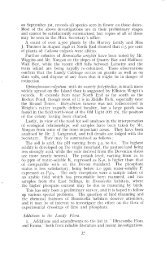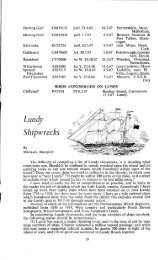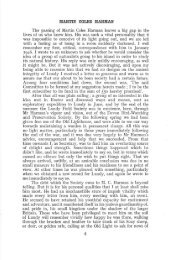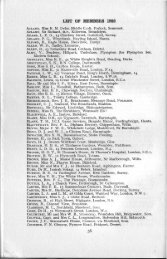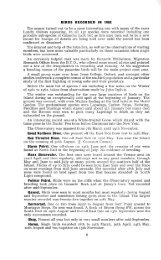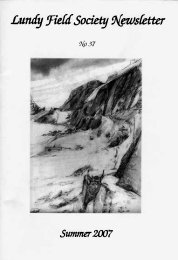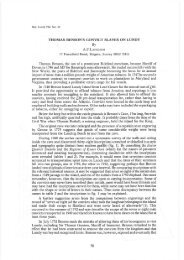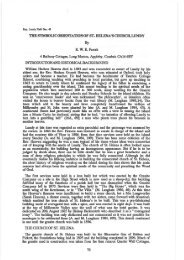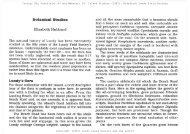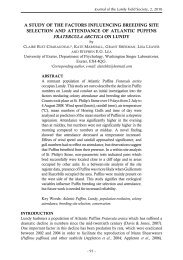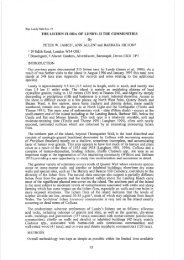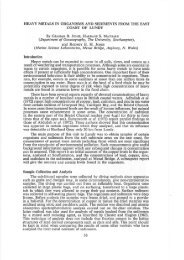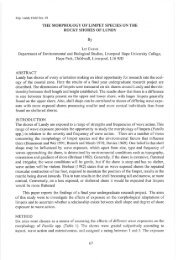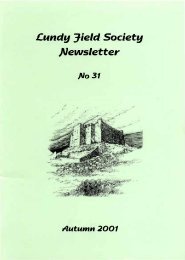LUNDY FIELD SOCIETY NEWSLETTER NUMBER 17/18 January ...
LUNDY FIELD SOCIETY NEWSLETTER NUMBER 17/18 January ...
LUNDY FIELD SOCIETY NEWSLETTER NUMBER 17/18 January ...
You also want an ePaper? Increase the reach of your titles
YUMPU automatically turns print PDFs into web optimized ePapers that Google loves.
2.<br />
little boats, disembarking more than 100 birdwatchers, and a full (267 seats) "Oldenburg".<br />
There was also a picture (WMN 30.11.87) of "four Lesser Detailed Twitchers" who "migrate in<br />
flocks to Lundy Island every year".<br />
Robert Farrah of the South Light is undertaking research into Leyllnes, with possible<br />
re fere nce to the re lative positions of stones and the mid winter sun. hope to tell you<br />
more about his findings next time.<br />
In this Newsletter we have a report on the work of the Bristol University Psychology<br />
Department on Lundy. Dr. Crook (who has supervised the research for many years) tells me<br />
that he has not published work on Lundy, but he has published on Weaver Birds of Africa and<br />
Asia; on Gelada Baboons of Ethiopia; and field research on Primates. He is currently led<br />
by his interest in animal research to research into human populations. He is working on<br />
the Ecology, Agriculture, and Social Life of Himalayan Buddhist villagers in Ladakh,<br />
observing how their ways of life adapt them to an extreme environment. Is not a Lundy<br />
connection with Ladakh quite something, then?<br />
Dr. Paul Munton (a student of Dr. Crook), whose thesis on Lundy Goats is in Bristol<br />
University Library, writes on Conservation topics for "the Times": on the Lynx (1.10.87)<br />
and Rats in India (5. 11.87).<br />
In the Spring an LFS Working Party planted trees; pulled up rhododendrons; put a fresh<br />
nylon rope and stake at Pilot's Quay, and a new one from South Light down to Mermaid's<br />
Pool, and another new one at the bottom end of the Quarry Beach Path. They also cut steps<br />
and put up a rope handrail on the South Light to Diver's Beach Path.<br />
An LFS member, being interviewed for October 1988 University places, found that Prof.<br />
Duncan of Liverpool University had an LFS report, and knew about the Hellgoland t rap. At<br />
Sheffield there were students who had done a guillemot count on Lundy. Dr. Dallingwater<br />
at Manchester knew of the Lundy spider count made by Dr. Luxton of Leeds, who Interviewed<br />
the LFS candidate from whom your Ed. gleaned all this. Dr. Luxton counted spiders on<br />
Lundy In 1987 and stays with J ane and Arthur Strick on Bardsey. Admittedly these<br />
connections are not as Far Flung as Ladakh, but impressive, nonetheless.<br />
At the AGM, someone had a copy of Bill Oddie's article on Lundy in "Country Life" (Nov.<br />
1986). I noticed Wm. 0 had used a phrase of mine from a piece I contributed to "the Lundy<br />
Chronicle". I sent a "Chronicle" to the Editor of "Country Life", suggesting I should<br />
have a copy of the Oddle article in exchange for my phrase, and they kindly sent one - I<br />
shall dine out on the story. I also had a very kind letter from Edith Pargeter (who is<br />
also Ellis Peters of the Brother Cadfael stories) when I asked how she came to use the name<br />
"Marlsco" in "All Excellent Mystery". "The Marisco family and their tangled relationships<br />
with Henry Ill and Richard the Marshall came into my acquaintance while I was writing the<br />
Llewelyn quartet. I knew the main family as Lords of Lundy, and adherents of Richard, who<br />
were fined and imprisoned by the king for supporting the Earl Marshall's cause, and<br />
afterwards suffered considerable misfortune and persecution after Richard's death through<br />
being Involved in the murder of Henry Clement, who had exulted In the murder at the<br />
Curragh. The Marlsco family had great influence in Ireland at the time. The two in this<br />
particular case were Geoffrey and his son William. There is a great deal of Information<br />
about them in one of the appendices to Sir Maurice Powicke's 'King Henry Ill and the Lord<br />
Edward'."<br />
The Lundy Aerogenerator ("Lundy Lights and Leads" again, literally, has alerted your Ed. to<br />
windmills, and in Jan. and Feb. '87 (WMN and the Gazette respectively) news of the<br />
Ilfracombe generator was published. The generator has generated a £68 mlllion export<br />
order, and was wired by the firm who wired the "Oldenburg", though "powered by Mother<br />
Nature". (Did any of you see the article - "Observer" 29.6.86 - "Electricity from the<br />
Wind" - John Puddy told me he was acquainted with the author, Colin Hope of Oxford?) In<br />
October 1987 the Electricity Generating Board had a double page advertisement in the<br />
Observer, "perhaps the day is not far distant when you will be able to turn on a TV set<br />
powered by .•• a puff of wind" ..• today Lundy, tomorrow the World.
3.<br />
In the "Sunday Express" (<strong>17</strong>.3.87) there was an article about the Association For All Speech<br />
Impaired Children (and an Open Space programme on TV befote Christmas); and the founder,<br />
Liz Browning, has written in this newsletter of its and her connection with Lundy. Her<br />
book "I Can't See What You're Saying" was reviewed by Dr. Mark Hubbard in the "Illustrated<br />
Lundy News" (Issue No. 10 1973 vol. 2 No. 4).<br />
J im Butcher (WMN 27.5.87) wrote a warm tribute to "Yewcas" Muller, sometime priest-incharge<br />
of Lundy. In June the Bishop of Crediton accompanied Lord O'Hagan (the Devon Euro-<br />
MP) to Lundy. Lord O'Hagan' s visit was "in response to an open invitation extended when<br />
he helped secure £40,000 worth of EEC grant for ••• the MS Oldenburg". The Bishop's<br />
visit was headlined as the first episcopal visit to Lundy, which provoked the Rev. R. C.<br />
Dixon to write about Robert Exon's visit In 1953; and A. J. Dennis to recall another<br />
Bishop of Exeter's visit in 19<strong>18</strong>, when AJD's father was tenant on Lundy.<br />
The Bishop of Crediton preached at your Ed. 's church a couple of months ago, and kindly<br />
talked with your Ed. about his visit to Lundy and the future of St. Helen's church.<br />
asked him about his interest In Lundy, and was amazed and delighted to hear he was a<br />
distant Harman connection. He has a longtime interest In North Devon churches; and you<br />
can see Lundy (and In good weather the church itself) from anywhere on the N. Devon<br />
coastline, so he has been aware of St. Helen's existence for a very long time, and, more<br />
recently, of what it needed doing to it. So he came to Lundy to look into these needs -<br />
which he sees as being on three levels. The Church needs to be preserved: it needs to<br />
provide for worship (he spoke of it as a witness to God, appearing as a first impression to<br />
visitors coming up the path to the top of the island): it needs careful adaptation so that<br />
both the two first needs are met, and today's. He expects there to be much wide-ranging<br />
discussion, and that he will be visiting the Island again while such discussion takes place<br />
There was a picture of the Bishop and Lord O'Hagan chatting to Denver Scoins (WMN 22. 7.87)<br />
and an article by Derek Henderson about the proposed Lundy pier - 150 metres long and<br />
costing half a million pounds. OH says "Lundy is a place all Its own - the natural beauty<br />
- rocky cliffs, the teeming bird life and the bracing wind all have their fascination •••<br />
(Lundy) is in good hands".<br />
No-one, in the WMN "Bishop" correspondence, mentioned that in June <strong>18</strong>97, the church was<br />
consecrated by Bishop Bickersteth, of Exeter. I wonder If any LFS member has seen the<br />
Church Plate, described in 1915 (Transactions Devon. Assoc. Vol. xlvil, referred to in<br />
Loyds' "Lundy" (p.44)). "The Chalice has a broad band with engraved InScription In old<br />
English capitals: CALICEM SALUTARIS ACCIPIAM ET NOMEN DOMINI INVOCABO. Marks:<br />
E.B. and J.B. (E & J Barnard) and London date marks for <strong>18</strong>60.<br />
Paten: Engraved round the Border: AGNUS DEI TOLLIS PECCATA MUNDI DA NOBIS TUAM<br />
PACEM. Marks as on Chalice but date letter for <strong>18</strong>66.<br />
The Flagon: has a pointed lid set with stones and an ornamental border set with amethysts.<br />
It is engraved with the words: SANCTUS, SANCTUS, SANCTUS. Marks: Maker HEW and<br />
London marks for <strong>18</strong>95".<br />
Do members know of Mr. Gade's words that are on a plaque Inside the church door? "<br />
the peace of the island is very important and that's something you can only find on places<br />
like this with no hustle and bustle, and no motor cars in particular.<br />
"Then I think the next advantage Is the freedom of the place. Although<br />
only one square mile, you never feel any sense of imprisonment at all.<br />
wherever you wish, you can do whatever you want to do. You haven't<br />
authority if you can do this or that, or go this place or that place<br />
privileged to enjoy such an Island.<br />
it's an area of<br />
You can go just<br />
got to ask any<br />
" Aren't we<br />
The WMN (27.11. 87) also had a splendid picture of the Rev. Donald Peyton J ones turning the<br />
hands of the clock on St. Helen's tower.
4.<br />
Peter Christie wrote an article about Capt. Dark (NDJ 3.9.87), who once made the trip from<br />
Bide ford to Lundy in his 40-ton cutter the "Gannet" in 103 minutes, under sail, and carrying<br />
mall (see Myrtle's piece in this Newsletter). PC also gave an account (NDJ 22.10.87) of<br />
how the golf course came to be built, in which he said of F. W. Gade's "My Life on. Lundy"<br />
(PC's source), that it must be "one of the most interesting books on Lundy". (There are<br />
copies available for sale if anyone likes to contact your Ed. - the original editions sold<br />
out.) Langham's "Lundy" (p.166 1st Ed.) says that Mr. Gade told the full story of the golf<br />
course in the "Lundy Review" of 1958.<br />
The word Lundyfoot occurred in "Call My Bluff" (29.9.87): the definitions were - Lundy foot<br />
rot contracted by sheep walking over sea-bird droppings on Lundy: Snuff served by Mr.<br />
Lundyfoot of Dublin: the U-shaped plate on a gun into which the towing bar was fixed by a<br />
Lundy pin. It was the snuff.<br />
In "Floyd on France" (Oct. 6th 1987 - ITV), there was background singing, referred to by Mr.<br />
floyd as the "Almost OK Chorale", "and the boys from Clifton" - this was Viv Hope Scott's<br />
Brittany tour (he and other Cliftonians are regular Tibbettans. Tony Cottrell was in<br />
Little St. Johns from Oct. to Dec. writing a novel. Your Ed. was going over on Dec. 5th to<br />
interview him at breakfast but S.E. force 6 stopped it: (next time!).<br />
Peggy Garvey (Devon Radio 21. 1 0.87) reported that the Lundy Pony Preservation Society has<br />
now been registered as a Charity. On Radio 3 (31.10.87) a Burton Page (the B-P's are fans<br />
of Square Cottage) was commenting on the music of Alexander Goehr.<br />
Sterling Melhuish was "hailed as sea blaze hero" by the WMN (27.11.87) he put out an engine<br />
compartment fire on the "Islander" in rough weather, and landed his passengers safely - Mrs.<br />
Gregory is reported as saying " . . . I must say Sterling handled everything brilliantly . •<br />
. we thoroughly enjoyed our holiday. We shall be coming again."<br />
While your Ed. was on Lundy in August, there were two glorious sailing vessels (a barque and<br />
a barquentine) in the bay, shooting the rough weather scenes for "Robinson Crusoe". The<br />
weather in the Seychelles and Yugoslavia (where the principal shooting was done) was too<br />
good. One of the vessels was called the CASTALOT because it has been in so many films.<br />
The Robinson Crusoe is AIDAN QUINN, who loved the island. Also in the bay was the sailing<br />
ship "Lord Nelson", which is specially designed to make it possible for the disabled to<br />
experience sailing. The Langhams and Sue Mills were shown over it.<br />
Remember the Gosse your Ed. still searches for. News of the Appledore Gansey (which I have<br />
knitted) at the AGM. Please write. If pieces are cut it is space not disagreement (even<br />
if I don't agree!) that forces cutting. A. T.V. B.<br />
TRANSPORT by John Puddy<br />
During July of 1985, the company who provided Lundy with a regular Saturday helicopter<br />
service, dropped the bombshell that was to change the future of Lundy's transport system.<br />
We were told that due to the outcome of investigations into the Isles of Scilly helicopter<br />
accident where the machine had literally flown into the sea, the C.A.A. were imposing new<br />
restrictions on helicopter flights over water. Although this had been to some extent<br />
foreseen, the real shock was that the restrictions were to come into force almost<br />
immediately. fortunately, due to pressure of numbers, we had already booked the twin<br />
engined helicopter for August and Castle Air were able to allocate this machine for the<br />
service for the first two weekends of September. The immediate problems were considerable<br />
but the long term implications for tourism on Lundy were disastrous unless a solution could<br />
be found. It was obvious that our only link with the mainland in the future would be by<br />
ship, so a suitable vessel had to be found. I should add here that the good ship Polar<br />
Bear, which since 1972 had performed stalwart service carrying cargo and building materials<br />
could only carry 12 passengers so unfortunately was unable to meet our future requirements.
5.<br />
My first problem was finding a means of locating ships for sale; this was quickly overcome<br />
by looking through the London Yellow Pages directory under the heading of 'Ship Brokers',<br />
there were hundreds - so what next? Write to them all of course, and we did. A pleasant<br />
weekend was spent addressing envelopes and sticking stamps (wi th a little help from our<br />
friends), then on Monday they were all dispatched on the Polar Bear.<br />
finance was also required for our ambitious project. The English Tourist Board and the<br />
E. E. C. were contacts; they both reacted wl th enthusiasm, even though In the past funds had<br />
not been allocated to the purchase of a second hand ship.<br />
In the meantime, we were getting some response to our many letters, my first reaction was<br />
that ship broking must be a risky business, as a considerable number of our letters were<br />
being returned by the Post Office. However, a few brokers who specialised in smaller ships<br />
sounded promising, and details of ships soon started to arrive. Ships (unlike motor cars)<br />
come in all shapes and sizes with no two being even slightly similar, so each set of details<br />
had to be thoroughly scrutinised. Our requirements were rather specialised, the vessel had<br />
to be able to carry passengers all year round not just cargo and she also required cargo<br />
handling gear.<br />
Difficult as it may sound, within a month we had a short list of some seven ships which we<br />
felt were worth viewing. All of them were lying In Norway, Denmark and Germany. We<br />
selected these countries as their passenger ship regulations were most similar to those of<br />
England, a vital factor in the choice.<br />
Towards the end of August, Barty Smith, a Lundy Director, and I set off to the continent to<br />
find our ideal ship. first we went to Norway where we saw the 'Strilton', a s·mart little<br />
vessel with excellent cargo capacity and a superb derrick, but unfortunately with very<br />
miserable passenger accommodation. Our next choice, the 'Hinna', was an elderly lady with<br />
excellent accommodation and a tiny hold. Her outward appearance was as if she had been<br />
involved in marine banger racing, with barely an inch of her hull undented, so on we went.<br />
'Imi' was a funny little ship lying In a Norwegian backwater, and was really a non-starter,<br />
adhering in no way to her glowing description, having recently returned from' oil rig tender<br />
service.<br />
Our next ship, the 'Pieqie', was in use as a floating restaurant in Oslo and had been<br />
altered far too much to be a viable proposition, even though she was a nice looking vessel.<br />
Her only salvation was that we had an excellent meal on board.<br />
By now we were beginning to feel that maybe we were wasting our time and that our ideal ship<br />
did not exist, but we carried on.<br />
'Vicky', our next ship, was right at the bottom of Norway at a town called frledrlckstadt.<br />
We arrived to find we were on the wrong side of the river to the ship. Even from that<br />
distance she looked terrible, lying in what can only be described as a ship graveyard. We<br />
lay down on the river bank In the warm summer sun and laughed, again the description didn't<br />
quite fit. After a while I hailed a passing speedboat and asked for a lift across to the<br />
'Vicky' which I felt we had to board after coming so far. Poor old thing, she was such a<br />
pretty little craft, trying to look proud in her menial houseboat role and with llttle<br />
future as a seagoing vessel. We spent ten minutes aboard then left.<br />
After an enjoyable day In Denmark we moved on to Germany and the MS Oldenburg.<br />
at Bremen station by one of the agents Involved in the sale, and driven to Wllhelmshaven,<br />
where we were entertained to an excellent lunch at a sea front restaurant, but what about<br />
the ship? At this point, the Oldenburg slipped gracefully Into view, she looked a picture<br />
adorned in numerous flags and her decks crowded with passengers. Lunch was finished and we<br />
were soon on board. She was a smart little ship, originally built for the German Railway<br />
Company as a ferry to operate between the German mainland, the Friesian Islands and<br />
Heligoland. The Oldenburg was running as a butter cruiser, that is she sailed on short<br />
cruises selling duty-free butter. For this duty the aft saloon had been gutted and<br />
converted into a supermarket, otherwise her condition was original.
6.<br />
An interesting afternoon was spent on board making four short cruises, each of which<br />
resulted in butter-laden Germans leavi ng the ship. The night was spent in Wilhelmshaven<br />
then the next day we moved on to Travemunde to see our last ship, the 'Dyroy' which, from<br />
her description was our most promising ship. She was lying at a yard near Tr avemunde. A<br />
very impressive looking ship, with high bow and business like appearance. Alas all was not<br />
good, for she had been owned by an enthusiast who had started to convert her into a dream<br />
yacht, but how many dreams come true? Her elegant timber clad i nterior had been gutted<br />
leaving only remnants of her former glory. Even her bridge had been fitted with a bouncy<br />
helmsman's seat. In the engine department however, she was a dream: the two enormous<br />
Blackstone engines, coupled to the single shaft, looked ready to go. Yes, she had<br />
potential.<br />
Out of our list we had only seen two ships which could su it our requirements, so how were we<br />
to make the final decisions; we sat pondering in a pleasant riverside bar when the answer<br />
came to us. We tossed the coin and the Oldenburg won the toss.<br />
We returned to Wilhelmshaven and the Oldenburg for a final look, she seemed to have<br />
everything, good accommodation,a hold, a crane and, most of all, she seemed a happy ship.<br />
The negotiations and formalities seemed to go on for ever, but eventually in November she<br />
was ours. The ship was drydocked in Wilhelmshaven to carry out essential maintenance and<br />
survey work, the white hull was painted blue and we were ready to sail.<br />
Back in England I mustered a crew for the voyage, which was to be the longest she had ever<br />
undertaken, and returned to Wilhelmshaven. We spent a few days getting to know the ship,<br />
taking fuel and provisions and sorting out what appeared to be an endless list of<br />
formalit ies, then we were ready to sail.<br />
We made a short trial run with t he ship's old Master and then, after dropping him off at the<br />
quay where we first saw the ship, set off for England. As soon as we Gleared the estuary<br />
we hit bad weather ; any misgivings about the Oldenburg's sea-keeping qualities were soon<br />
dispensed with, and we found her to be a good ship, able to maintain speed In adverse<br />
conditions.<br />
It was not long, however, before an unforeseen difficulty arose. For the l ast four years<br />
the ship had sailed mostly in sheltered waters and the tossing around was dislodging silt<br />
which had built up in the main fuel bunker tanks. This silt very quickly started to clog<br />
the main engine fuel filters, starving t hem of fuel and gradual ly reducing the speed. The<br />
filters were changed, but because of t he long journey ahead of us we decided to put in and<br />
purchase a good stock of spares.<br />
Fortunately, the River Embs leading to the port of Emden was close by and, aft er anchoring<br />
overnight, we proceeded during the next morning to Emden where our ever reliable agent was<br />
waiting for the ship with several boxes of f ilters; we thanked him for his excellent<br />
service and proceeded downstream towar ds the sea.<br />
The ship performed beauti fully and sped down the English Channel in fine style, with a stiff<br />
breeze attempting to slow us down, but wi thout success. The anchor was dropped, however,<br />
off Dunkirk when a gale was forecast for the sea area which we were entering. The day went<br />
by with no sign of bad weather and the decision was made to heave up and proceed across to<br />
the English coast and the Isle of Wight , and straight into the gale which was late arriving.<br />
Again the Oldenburg showed that she was not afraid of bad weather and butted into a heavy<br />
head sea with enthusiasm.<br />
The heavy weather stirred up even more sludge in the fuel tanks requmng even more regular<br />
fuel filter changes which, of course, meant that our seemingly adequate stock of filters was<br />
being used up. The bad weather continued and it was decided that we could just make Poole<br />
Harbour on our diminishing filters.
frith's photographer arrived in July and took many pictures of the island (frit hs of<br />
Rei u'lte}.<br />
10.<br />
In 1vlarch, Waiter departed to try his fortune in Canada. Mr. Wright planted more than 1,000<br />
bulbs, wit h the idea of star ting flower farming a la Scilly Isles - no more was heard of<br />
this subsequently. The year ended with torrential rain, and stormy weather causing· a<br />
shortage of supplies - "tempers generally tremelo".<br />
THE UNIVERSITY Of BRISTOL ANNUAL COURSE IN ETHOLOGY (ANIMAL BEHAVIOUR)<br />
(as report ed to the Editor )<br />
Short field-study projects are set up, the students usually working in pairs. Students are<br />
bei ng trai ned in method. Kittiwakes are the predominant study, because they ar e<br />
accessible, and t here is plenty of data. Students are being trained to use data to answer<br />
specific questions, depending on the project. for example, is reproductive success<br />
different in differing parts of the Kittiwake colony - i f so, why? Does such success depend<br />
on exposure to climatic conditions? Does local risk of predation differ? Do older birds<br />
prefer certain areas and do better there?<br />
John Coulson of Durham University has observed the competition among kittiwakes for the<br />
centre positions in the colony. Adult kittiwake males, being heavier, win central<br />
positions from immature birds. JC has also observed that success in rearing fledglings is<br />
highest i n the central area. Parental changeover on nests is efficient at the centre, and<br />
parental partnerships are longer, and re-occur each season. There is a higher "divorce"<br />
rate and lower efficiency on the periphery. These observations are based on JC' s 30 year s<br />
of collecti ng data and are used as t he basis f or the Bristol work.<br />
Not only Bristol University uses J C' s work as a basis for Its own projects but so do<br />
Liverpool and Exeter Universities.<br />
In the "Lundy Island Chronicle" (of 1984: Vol. 2, No. 1 (and only), pp6 and 8)t there are<br />
articles on kittiwake fr atr icide by David Dickens of Liverpool University.<br />
Larks are the subject of another pr oject. The question posed Is - how do larks distribute<br />
themselves territorially? They appear to sing within definite areas, so t hat it may be<br />
hypothesised that there Is a notional boundary within which each lark sings: such<br />
boundaries would be mappable. Supporting evidence for such an hypothesis is the unique<br />
song of each bird. (But there Is room for Ph.D. work on such l ar k song. Each song needs<br />
to be tape-recorded, and an analysis made of its content in phrases and repetition of<br />
phrases. Does each lark have a recognisable, individual range of songs? It is supposed<br />
it does, but i nfinite variety could occur, which would mean the song was useless as<br />
evidence. Such a recording, while it has been attempted for blackbi rds, has never been<br />
done for larks.) Some 12 t apes have already been made for a small current project, a<br />
Lundy project, which Is to play the tapes back to larks In assorted combinations (own song<br />
and/or others). When a tape of Bird A is played, and the song is assumed for the moment to<br />
be territorially marking, then neighbour B is to be observed responding (with Its own<br />
territorial marking song) or not. Students are simulating nature i n a devised sequence in<br />
order to see if predicted effects materialise.<br />
Wrens are also the subject of a short project f or Lundy. A pilot study of wren territory<br />
is being undertaken using song to identify location and extent of territory. Wren song is<br />
more stereotyped than larks. Lark song may contain more Information than wrens'.<br />
Goats and Soay sheep are also used for project work as training In research method. (Dr.<br />
Paul Munton' s thesis on Lundy goats is in t he l ibrary of the University of Brist ol.)<br />
Attempts are made to answer such questions as: how do they use the island?: what kinds of<br />
parties do they move in?: when and where is the rut?: what are the sex ratios?
11.<br />
Differences in maternal behaviour between different breeds of sheep are matter for another<br />
project. Criteria by which maternal behaviour is judged are: distance of mother from<br />
lambs: frequency and duration of suckling: how protective mothers are. Welsh mountain<br />
sheep appear to have a stronger bond than others; ewe and lamb stay closer together, and<br />
suckling Is more frequent, although not necessarily of longer duration. The Suffolk hybrid<br />
appears to show the least maternal behaviour.<br />
In 1986 Guillemots were the objects of a research project. They were observed so that food<br />
brought to the chicks was Identified, so that the diet of Lundy guillemots could be compared<br />
with that of Skomer guillemots, the differences being due to different patches of sea being<br />
fished.<br />
Dr. John Crook has done many years of field work on Lundy in psychology and zoology; and<br />
this time was accompanied by Dr. Robert Weevers, Dr. Arthur Goldsmith, and a Barn full - all<br />
of the Bristol University Psychology Department. In the late 60s, Professor K. R. L. Hall<br />
(professor of Psychology, University of Bristol) started the annual courses on Lundy to<br />
train students in field work in the manner of Tinbergen's courses at Ravenglass for Oxford<br />
University.<br />
MY INTRODUCTION TO <strong>LUNDY</strong> by John Dyke<br />
My introduction to Lundy originated in an unusual way fifty years ago when I was living in<br />
Cheshire. I had just purchased a 1s. 9d. postal order in the one and only village shop and<br />
noticed a 'foreign' coin in my change. Our postmaster was apologetic and Immediately<br />
offered a replacement penny. I thanked him, but declined to part with this strange coin<br />
"Lundy one Puffin" - where on earth was Lundy? I concluded that it had been minted for<br />
some obscure overseas British possession (we had an empire in those days).<br />
Searching through my Phillips Atlas at home, I found that Lundy was a solitary piece of land<br />
surrounded by water and nearer to England than I had expected. How inviting it looked In<br />
isolation; I vowed I would visit Its shores as soon as I could. Greatly daring - to quote<br />
Rupert Bear, - I wrote to Martin Cotes Harman, whose stern profile appeared on the coin, and<br />
asked for any available Information about the Island and whether it could be visited. In<br />
due course, a courteous reply was received together with a mint set of the 1929 stamp issue<br />
- an added bonus as I happened to be a collector. Mr. Harman expressed a hope that I would<br />
Indeed visit Lundy and referred me to his agent, F. W. Gade who would be able to deal with<br />
further enquiries.<br />
And so it fell to Mr. Gade to have to grapple with the requests of an Impecunious art<br />
student who had fallen In love with a piece of rock out In the ocean. Mr. Gade dealt with<br />
my many and varied questions most obligingly, and from him I purchased every available<br />
postcard view of the Island - and what literature there was, including joan Watt-Smyrke's<br />
little guide, published in 1936, price 6d.<br />
Meanwhile, searching Chester's second-hand bookshops, I secured Goss's "Sea and Land" for<br />
one shilling, and Warden Page's " Coast of North Devon and Lundy Island" at a cost of 7s. 6d.<br />
I commenced collecting anything connected with the Island, but was disadvantaged by living a<br />
great distance away from the object of Interest.<br />
In 1939 I managed to persuade my brother In law to join me In making tentative arrangements<br />
to visit the island for a fortnight's stay at the Manor Farm Hotel In May 1940. In agreeing<br />
to join me, my brother in law - a qualified brewer - was attracted by the prospect of<br />
visiting the unlicensed tavern - and Lundy - in that order.<br />
Eight years were to elapse before I actually set Wellington on Lundy's shores. By then, of<br />
course, through the Instigation of Mr. Harman, Dr. Harvey (later Professor Harvey) and<br />
associat es, the Field Society was established In 1946. Mr. Harman generously allowed the
12.<br />
society to occupy the old Light and make it its headquarters - it was ideally suited for the<br />
purpose. Nearly all the other buildings had suffered the depredation of wartime storm<br />
damage - virtually impossible to repair through lack of labour and materials.<br />
The society's pioneers, with great determination and effort, cleaned, decorated and<br />
furnished the interior of the Keeper's cottage, creating really acceptable accommoda.tion,<br />
whilst the fabric of the building contributed a special atmosphere of its own. Volunteers<br />
also erected the first Heligoland Trap at the head of Millcombe Valley close to the old<br />
hotel's gothic gate. Severe gales blew down their efforts - twice!<br />
Food rationing was still in force: each visitor had to bring food for a fortnight.<br />
Generally rations were pooled. Nothing was available for purchase excepting fresh milk.<br />
A small barrel of beer came ashore with us but that had been consumed in the first two<br />
evenings and the tavern remained dry thereafter whilst we were there.<br />
The "Lerina" having been commandeered for war service was in need of a complete overhaul<br />
afterwards so that the island had no boat of Its own at this time. The Field Society<br />
chartered a small fishing boat, the "Girl joyce" to run fortnightly out of Ilfracombe.<br />
Supplies for the island's few inhabitants were also carried on these occasions.<br />
I recall arriving at Ilfracombe on the early morning train from Exeter, in pouring rain,<br />
accompanied by a westerly gale. Fortunately it was down hill all the way to base camp,<br />
"The Tranmere Hotel" in St. J ames Place, run by dear Mr. and Mrs. Cutcllffe who were so<br />
kind, consoling and considerate. Stan Cutcllffe was the LFS Shore Officer, a keen<br />
naturalist and ornithologist. Already assembled at the hotel were my fellow passengers and<br />
all eleven of them and myself voiced little objection when it was announced that Captain<br />
George lrwln had decided that it would be unsuitable to venture forth on the very high seas<br />
that day.<br />
On the following day, many of us had the distinct feeling that we ought not to be on the<br />
high seas that day either! Some of the passengers being unfamiliar with ways of small<br />
fishing craft, chose to sit, recline and roll on the hatchcover amidships, finding<br />
themselves completely at the mercy of the enormous waves and wild billows. Persons were<br />
rather ill and others wished they could have been!<br />
The covered area was occupied by the skipper and his crew. They said lt was necessary that<br />
they should remain In that favoured position In order to keep their sandwiches dry and also<br />
that it was important to have a tight grasp of the wheel and the beer cask!<br />
What a blessed relief it was coming under the lee of the island, when the "Girl J oyce" shook<br />
her self for the last time, dropped anchor, and jack Crews, a skilful sculler, was soon<br />
alongside to take off the drenched but thankful passengers. Jack, and his wife Dorothy, had<br />
lived on the island before the war, had returned In 1947, and were living In the habitable<br />
portion of the old hotel with their daughters joan and Margaret.<br />
We all got ashore safely, the boat having to be run up on the beach each t ime, and were<br />
welcomed by Rosemary Studdy who was taking care of the old Light and the Society's affairs<br />
during an interregnum, the first appointed warden Roly Barker having accepted a post In<br />
Canada. His successor, Hugh Boyd, was to arrive at the end of the month. He was the<br />
first of a long line of qualified ringers and had been an assistant to Peter Scott at<br />
Slim bridge.<br />
As we wended our way up the beach road, lt was thrilling to see the beauty of the Island in<br />
reality after having already familiarised myself with the help of the aforementioned post<br />
card views. There was the South Light, the beetle-browed cliffs with Marisco Castle a-top,<br />
the ruined fish palace, the limekiln, the lone pine - then In full vigour - and so on - lt<br />
was one of the greatest moments of my life.<br />
On arrival at the Old Light, we rapidly changed into dry clothing and festooned our damp<br />
garments above the stove in the common room.
13.<br />
The main purpose of my visit was to look around and choose some subjects suitable to<br />
illustrate the 1948 Annual Report. The Society had no badge, emblem or logo (to use modern<br />
parlance) and I quickly decided upon the Old Light tower and lantern as expressive of the<br />
Society's established purpose. On the following bright and sunny morning, I selected a<br />
suitable site and commenced a water colour painting of this majestic granite tower. After<br />
about 20 minutes the subject, to my consternation, began to disappear. We all know how<br />
particularly vulnerable Beacon Hill Is to sudden sea mists and fog banks. In its more<br />
extensive form, especially if it covered the airfield, fit. Lt. j. E. L. Drabble of "Devon<br />
Air" used to refer to it as "Mr. Harman's private bloody cloud".<br />
On the day following, I completed the water colour and later made a scraper board adaptation<br />
for the annual report covers.<br />
The following year, I stayed at the Old Light from June 1 - 10. Hugh Boyd was warden,<br />
assisted by Stan Ball, a jolly ex naval man who later became Hon. Treasurer of the Society.<br />
Stan, true to naval tradition, was very adaptable and undertook the cooking and<br />
housekeeping. I recall that the greens were rather high in protein due to the cook's<br />
shortsightedness, but he more than made up for this with his marvellous story telling,<br />
principally about his first war service, on a small naval craft on the Caledonian canal -<br />
comic situations r eminiscent of the "Para Handy" stories.<br />
Hugh Boyd concentrated part of his time on studying the growth and development of shag<br />
nestlings at the northern end of the west coast.<br />
I sketched him making a daily descent to an otherwise Inaccessible nesting site by way of a<br />
rope ladder - a courageous exercise, as he had to contend with a gammy knee caused by a<br />
cricket ball injury. That demonstrated the dedication which Hugh always gave to his work.<br />
I usually managed to visit Lundy at least once or twice each year thereafter, thanks to my<br />
considerate wife, who came over only occasionally when our children were young.<br />
An unusual occurrence took place In April 1957 when my colleague Eddie Spiegelhalter and I<br />
were stranded on the Island for four days, on a visit which was to have been no more than an<br />
over-night stay. Trevor Davey, skipper of the "Lundy Gannet", was obliged to leave his<br />
moorings in a hurry during the night in the face of an Increasing easterly. The Rev. Roy<br />
Dixon was also Incommoded by the "Gannet's" sudden departure, and because of a shortage of<br />
world news our predicament was reported In the press, on the radio, and black and white<br />
television!<br />
There was a superbly organised excavation in June 1957 on an exceedingly hot summer's day -<br />
the scene of activity, Parsons Well, near friars Garden. Mr. and Mrs. P. Cole were<br />
participants and one who desires to remain anonymous, but who were the others? The day's<br />
work resulted in raising a lot of silt, which was beneficial to the surrounding pastures no<br />
doubt, a minute fragment of wood (part of hatch cover) and the counter sunk bronze ring<br />
belonging to the said cover.<br />
Over the years, I have derived tremendous pleasure from my association with this beautiful<br />
isle. I could continue to reminisce but then you would miss all your trains and buses<br />
home. I will therefore close by expressing my gratitude to the late Martin Cotes Harman<br />
and family for readily granting me permission to come ashore in those early post war days,<br />
and to Mr. and Mrs. Gade who were always so welcoming.<br />
Perhaps I may continue this saga on another suitable occasion.<br />
MY TIMES ON <strong>LUNDY</strong> by Elizabeth Browning, M.B.E.<br />
I first went to Lundy when our friend Diana Keast found that Hammers was empty for three<br />
days In July 1968. I met her touting for takers (she always was a good salesman) and my<br />
husband George, son freddy and myself fell for it. Thus our love affair with Lundy began.
I have no desire to add our reactions to that first trip on the Balmor al, first sight of the<br />
island, landing and climb, to all the other recorded accounts because we know (as does<br />
everyone else who has had this experience) t hat ours is different, meant more to us than to<br />
anyone else and is much, much more special than anybody else's could possibly be! • • • If<br />
anyone wants it they can write for it, it is not up for grabs! In typical Lundy fashion. we<br />
had, during those three days, all kinds of weather, our third day being a summer dream<br />
during which we walked to the North End. By this time there wer e only two people in love<br />
because George was suffering qui te severe vertigo from the cliff heights of the jig-saw<br />
piece this island is, lying as it does on a black, grey or blue table top accordi ng to the<br />
state of the sky. Mountain goats were what Freddy and I discovered ourselves become until<br />
we climbed the stairs to the Old Lighthouse when it was then our turn to be overcome and,<br />
feeling distinctly queezy we pressed ourselves backwards against the round of the light<br />
chamber while compelled to look out to see the marvellous ALL around us. While we felt<br />
sick, George was happy up there, it is perhaps a common experience that some can 'take'<br />
natural heights but not those made by man and vice versa? Thus it was when, as we stood<br />
with our baggage on the beach and Diana asked if anyone could consider retur ning to cook<br />
for the divers for two weeks paid work the following month, she recruited but two<br />
volunteers. Freddy and I returned, my associ ation with Lundy began and our story is<br />
recounted in a book I wrote 'I Can' t See What You're Saying' published in paper back by<br />
Angel Press Chichester or available in hard back published by ELEK BOOKS from libraries.<br />
That first experience In the Old Light when, busy though we were with the job we had on hand<br />
still lent some time for exploration of the island, was sufficient to set my imagination<br />
working and I knew that this diving scene so admirably organised by the Don Shiers<br />
enterprise (regrettably excluded from mention in Mr. Gade's book) had potential for social<br />
exploitation and the area of my interest was what was then known as Borstal Training. I<br />
returned from that for tnight burning with ambitious desire t o see Borstal lads learning the<br />
discipline of good diving practice, being part of a group made of a rar e comprehensive<br />
social mix, sharing all chores and in the environs of Lundy Island. I set about forthwith<br />
writi ng up my propositions in project form. (Details available on request. Send SAE to<br />
me c/o Editor) The day dawned when I arrived at the Home Office for confrontation. I had<br />
covered and could qualify every aspect of my scheme (or so I t hought) and had even acquired<br />
a couple of sponsor s to cover the considerable costs for two lads to partake in a week's<br />
Instruction with Bristol Channel Divers. I could answer every query put by the t eam I<br />
faced except one. This was the burning question of safety and I then knew that no matter<br />
what I said regarding the safeguards I knew were solidly built-In to the t r aining programme<br />
and maintained with watchful care at all times, there was no way the Home Office was going<br />
to risk the Mirror headlines DIVING DISASTER BORSTAL BOY DEAD. I left Victoria punctured<br />
and my disappointment sank to the soles of my f eet wher e it stuck like a load of lead.<br />
14.<br />
Lundy's magic worked like yeast in a mysterious way. It bubbled continuously in the back<br />
of my mind for several years rising and r eacting at last in 1974 when I was working for the<br />
Association for All Speech Impaired Children. A group of 24 children suffering speech and<br />
language disorders had been Activity Weeklng at Edgehlll College with Outdoor Pursuit<br />
Instructor Tessa Huggett (a r egular diver with Bristol Channel whom I had met when cook,lng<br />
on L undy). We had been given free passages by the Campbell Steamship Company for a day<br />
trip to Lundy whence we arrived groggily but upstanding. There had been an 8th birthday<br />
celebration on board . .. only those proved ' Good Sailors£ could f ace the cake which the<br />
captain came down t o cut. There was intense excitement among us as Balmoral let her anchor<br />
down and the small boats chugged alongside for landing us all. Everyone enjoyed the short<br />
time available spent on shore and as the party left, two older boys and myself stayed behind<br />
along with Fritz Kolbe, a Swedish friend who, on his ver y first visit to England, had found<br />
his way to Bideford hitch hiking from France, ferr eting us out at Edgehill. Freddy too was<br />
with us and a climbing instructor from Bristol gave his time for t he following week when,<br />
sharing the Old Light with the divers for whom I was cooking, these young people with their<br />
devastatingly socially debllltatlng difficulties enjoyed a week being made to feel equal<br />
with others, accepted (and so acceptable) as mortal men and valued as such. I watched<br />
from t he kitchen door way as morale mounted and I delighted in all I saw. Of all our<br />
faculties, being able to speak and understand is the most vital. I believe what we all<br />
most dread is being blind but a blind friend once told me not to worry about her for she
15.<br />
said, 'I've got my brail telephone and so can ring my friends, I go to the park with my<br />
white stick on nice days and people come and sit with me and chat, above all, I have my<br />
radio ••. being deaf is what I dread and those are the people for whom we should have most<br />
care because they are isolated'. So it is for those born with all other faculties intact,<br />
people who are not mentally handicapped, not physically handicapped, not deaf, autistic or<br />
emotionally disturbed but whose IQ is average yet their speech and good understanding<br />
capability has failed to develop. They cannot cope with the speed and competence ·with<br />
which the rest of us think and speak (two skills we all take entirely for granted).<br />
Society expects and demands that its members will, as they go around looking like everyone<br />
else, be able to understand the spoken word and speak it. Someone struggling all the time<br />
hoping against hope they've 'got' the meaning and having a lot they wish to say In reply but<br />
unable to muster the 'right' words in time, finds themself simply left behind. No-one will<br />
give such a person that little extra time needed and without which they just cannot cope and<br />
so, feeling rejected, discarded and of no worth, it is hard to contain and manage the<br />
emotions of rage, inadequacy, depression and frustration, not to mention loneliness which is<br />
the experience if this is your specific problem.<br />
from that t i me on I came to Lundy with small groups of older speech impaired people to climb<br />
and explore and we occupied the Old Light or Signal Cottage according to our numbers. We<br />
were always accepted by the Islanders and other holiday makers as perfectly ordinary people<br />
and this attitude, coming as it did convincingly and not contrived, was a great boost for<br />
the confidence which everyone so much lacked. Darts teams formed up in the Tavern and<br />
matches took place while rounds of drinks were bought between the general company and<br />
ourselves equally. In the environs of Lundy the sickening pressure of life on the mainland<br />
causing as they do so much intense anxiety for those with communication problems, fell away<br />
and the 'young' feeling secure, began to relax In which happy state they also began to grow.<br />
They were great t i mes and all who partook In those adventures have the memories of Lundy<br />
branded for ever on their hearts. Those experiments resulted in the ultimate adventure so<br />
far when in 1986 twelve of us went to the States on a camping expedition with Trek America.<br />
During the three weeks were were there we spent time in New York City, Niagara falls,<br />
Washington DC, Chatanooga, New Orleans, Orlando an Florida Keys. Of the four boys and four<br />
girls all aged between eighteen and twenty-seven, all either in work or training, three of<br />
them were Lundy-ites. Again, as on Lundy, the experience of an exciting adventure<br />
stretched all our minds and gave new and further confidence with which to face our lives on<br />
return.<br />
So what about the Borstal Boys? Well, once again I found myself at the Home Office and<br />
this time the visit resulted in lads becoming involved in a successful and happy scheme -<br />
Af ASIC* got off the ground over eleven years ago when three young men joined three different<br />
AF ASIC Activity Weeks as links looking after a speech impaired child one-to-one. This<br />
scheme Is still going strong and is still a happy successful exercise. Borstals as such<br />
are now a thing of the past, young men in certain circumstances undergoing what Is now<br />
termed Corrective Training. We have not as yet achieved 'Borstal Boys and AFASIC children<br />
and on Lundy and at the moment the inclusion of diving as an activity is not appropriate.<br />
Rents on Lundy are now way beyond the Af ASIC members' purses and indeed the purse of the<br />
association which has to find the expenses for the support teams as well as all the links.<br />
These teams consist of an organiser, a speech therapist and an outdoor pursuits Instructor<br />
and with the links each acting one-to-one we make large parties. No accommodation on the<br />
island can contain groups l ike these, all come from different parts of the British Isles so<br />
to get everyone assembled and down to North Devon, across to Lundy and back to their homes<br />
again, all within the confines of a week (the most time the professionals Involved can<br />
spare) is not realistic. for the moment Lundy must remain a treasured memory and constant<br />
inspiration for those who have been and a dream which may yet be realised in some form for<br />
those who see the photos in the files. As for me, I realised an ambition three years ago,<br />
when with Tessa Huggett, we stayed in Signal Cottage for a week in winter. freddy and I<br />
had often fantasised a whole four months in Tibbetts in wintertime, tantalising ourselves<br />
with questions such as what we would do all day, whether we had the Inner resources by which<br />
to sustain ourselves, If we could cope with the physical discomfort, survive without a<br />
record player etc. It was a game we played knowing full well ther e was no possibility of<br />
our putting our selves to such a test. That week with Tessa presented no hardship at all
16.<br />
for, although due to thick fog our helicopter flight was postponed for a day and while we<br />
had a nine force gale and a good deal of mist, most of our days were so hot, a cotton shirt<br />
was too much clothing! Lundy in winter was after all, just Lundy!<br />
*The first International Symposium on SPECIFICALLY SPEECH AND LANGUAGE DISORDERED<br />
CHILDREN was organised by Af ASIC at Reading University in March 1987 - 670 participants<br />
attended this, the first EVER world meeting on the subject and there was representation from<br />
26 different countries.<br />
<strong>LUNDY</strong> ISLAND by Kay Rawson<br />
A climber does not look for simple sport, but for a blend of many things. There is the<br />
pleasure of strenuous exertion in the open air, the exploration of new places, which are<br />
often strange and remote, and the spice of danger, which however low the grade of climb,<br />
however much equipment and technique is used, is always present In the climber's mind.<br />
There Is also the almost Indefinable pleasure in the texture of the rock, its smoothness or<br />
roughness, its shape and features, and the unique quality in every climb. And there is the<br />
exposure, the sensation drawn from the drop beneath one's feet and the empty vault of air.<br />
This is not caused by a sense of danger, but a delight in the sheer paradox of the position,<br />
and perhaps by the savouring of a controlled feeling of vertigo. It is a pleasure which<br />
has many addicts.<br />
Lundy Island can offer all these things to a climber. Although it s close to tourist<br />
Devon and its traffic jams, ten miles of sea and tide rips In the Bristol Channel make lt a<br />
separate world of quiet tranquillity. It Is a place of varied attractions, of which its<br />
natural history is perhaps the greatest, as it is the home of many seablrds, and its coast<br />
is now a marine nature reserve.<br />
It even has a little human history as well, although Its inhabitants in the old days must<br />
have made a poor living. The island's past has been involved with sheep, lighthouses and<br />
shipwrecks, some of the latter even being accidental, but many brought about by the<br />
islanders themselves for the sake of plu nder. But, of course, for a c li mber the greatest<br />
attraction of Lundy is Its crags and sea cliffs.<br />
One climb Is famous above all Its others - the Devll's Slide. This spectacular ramp of<br />
pale granite rises from the waves of the western shore and sweeps steeply upwards for over<br />
400 feet. The c lassic route is not a hard climb by present standards, but what climber<br />
could resist such rock? We started where the waves break on the rocks as the swell rolls<br />
in from the wet, moved up the edge of the slab on good holds before the rising tlde reached<br />
us, and climbed easily away from the sea. A hundred feet, two hundred feet, here a belay,<br />
there sometimes a peg, the sensation of space and exhilaration growing as the exposure<br />
mounted. Half way up there was a traverse. Then once again we climbed the edge of the<br />
slab on delicate holds which diminished foot by foot up to the delightful last traverse made<br />
in classic slab climbing style, balance and friction leading us to the top.<br />
On the centre of the great slab is a route called the Devil's Slip, which will give the hard<br />
climber food for thought. We didn't do it, but In our stay on Lundy we tried many other<br />
climbs, some hard, some easy, some Impossible, although we only touched a fraction of the<br />
climbs that are there.<br />
We stayed in the camp site but often ate in the bar. The site was grassy and sheltered and<br />
not overcrowded. If you have a good tent camping is a wonderfully relaxed style of holiday,<br />
especially if you do not have to cook too often. A good tent? Well Lundy does have<br />
British weather, and probably not the best of it either. It has its share of rain and<br />
gales, cloud and sea mists. In the old days these may have helped the inhabitants with<br />
their ship-wrecking activities, but the modern visitor may not welcome them: We were<br />
lucky, as we had reasonable weather during our visit, and we found Lundy an ideal place to<br />
watch the world go by, to potter about or to do absolutely nothing at all, when we didn't<br />
want to climb.
<strong>17</strong>.<br />
It was sad to take the boat back to the real world.<br />
forgotten that it was there.<br />
ST. HELENA BY THE SEA by t he Bishop of Crediton<br />
A fter a few days on Lundy we had almost<br />
Have you ever seen St. Helen's Church on Lundy Island? You can, just about, with a good pair<br />
of binoculars from Hartland Point on the North West Devon Coast. The island is about twelve<br />
miles away, and the Church stands up boldly on the top of the cliffs at the southern end of<br />
Lundy.<br />
You can see that Church better, of course, sailing through the channel between the island and<br />
the mainland, on a yacht or fishing boat or best of all from the new ferry M.S. Oldenburg<br />
which sails to Lundy ever y day in the summer, from either Bideford or Ilfracombe, according to<br />
the t ides.<br />
From the landing stage, walking up the steep path for some four hundred feet, St. Helena's<br />
Church is the first main building you come to. It is surprisingly large, with an impressive<br />
tower, built with local granite from the island quarry and completed in <strong>18</strong>96. Looking at the<br />
Visitors' book in the Church the other day, it was clear that many people look In each day,<br />
and that they come quite oft en from Devon, but also from all over the world.<br />
Inspiration for building this Church came from the Rev. H. G. Heaven, the then owner of Lundy,<br />
who was also a clergyman. The island was known at that t ime as the Kingdom of Heaven! He<br />
is thought to have planned such a large building because In those days many flsherboats from<br />
South Wales, Devon and Cornwall put In at Lundy early on Sunday mornings, and the cr ews went<br />
to Church bef ore r efreshing themselves In other ways at the inn next door. Occasional<br />
services are still held there when the priest In charge, t he Revd. Andrew Edwards from<br />
Ilfracombe can get across, and other clergy also help. That apart, the building remains ln<br />
itself an impos ing reminder that Christianity has taken root here, and the present residents<br />
are glad to have it so.<br />
St. Helena is the very suitable patron saint of this Church. You can see a statue of her in<br />
a niche above the door. She ls famous as the mother of the Roman Emperor Constantlne. A<br />
devout Christian herself, she has been honoured through the ages for the Churches she founded<br />
In Jerusalem, and for her discovery of the Cross on which Christ was crucified.<br />
In mediaeval times, Helena was often supposed to be British, the wife of a Roman General who<br />
lived in Britain, or else married to the minor English King Coel of Colchester, old King Cole<br />
of the nursery rhyme. Dorothy Sayers once wrote a play about all this, and some years ago,<br />
when I was the Honorary curate of St. Helen's Church, Bishopsgate, a centre London Church<br />
quite near the Bank of England, the story was that a Church had been originally built on this<br />
site on the direct order of Constantine when the news reached him that she had found the true<br />
cross. Legends apart, the name Helen, and the similar name Eleanor, take us back to the<br />
fundamental Christian truth - in the Cross of Christ Is our true peace. Helen's famous son<br />
Constantine has been always remembered as the man who made the Roman Empire Christian,<br />
allowing the previously persecuted church to come Into the open, build churches and preach the<br />
gospel freely. He made Sundays into public holidays, was a great defence of Christian<br />
orthodoxy and a friend to many Bishops of his day. Although he delayed baptism until a year<br />
before his death in 337 ad. , by then he had established the Christian f aith Irrevocably In<br />
Europe and t he Mediterranean lands. I have often wondered how much his mother Influenced him<br />
in his journey towards faith. There is no direct evidence in the historical documents we<br />
have from the period but I think she was bound to have had an effect on him. That may be<br />
romantic, but you can see why I am glad Lundy's Church Is dedicated to her.<br />
(Ed's. note - the Bishop kindly said I could use this article in the Newsletter.)
THE NORTH END: THE LIGHT, LONG ROOST, PUFFIN SLOPE, AND KITTIWAKE GULLY<br />
by A. J. B. Walker<br />
<strong>18</strong>.<br />
1 82 (Newsletter 12) Needle's Eye/Montagu Steps/Pilot's Quay<br />
'83 ( 13) Battery/Earthquakes/ Jenny's Cove<br />
'84 (14) St. j ames' Stone/Copper Adlts/Long Adlts<br />
'85 ( 15) SW Polnt/Devil's Llmeklln/Roose/Rat Island<br />
'86 ( 15) Upper & Lower East Side Paths/Brazen Ward<br />
'87 ( 16) The Castle/Benson' s Cave/Benjle's Chair/Pilot's Quay<br />
This Is a leisur ely afternoon outing - take a bottle of water, because it's a good 3 miles ou t<br />
even if you keep t o the main path. (Ed.'s note - For the less vigorous, the journey ou t and<br />
back takes 1. 5/2 hours without any stops to look at things or eat - so a whole morning with<br />
lunch Is a good Idea. Your Ed. has had a birthday breakfast there.)<br />
Simply bead to t he North from the High Street Gate (the Old Light Is a few hundred yards to<br />
your left). Halfway to the Nor th end, you'll get t o Tlbbett's; carry on North past Gannet's<br />
Combe, and Northwards again past John O' Groat's house (on your right) to the big H set In the<br />
ground to mark the helicopter landing place for supply ing the North Light. Now Long Roost is<br />
t o your left - it's the west siding for several hundred yards - the North Light, Puffin Slope<br />
is to your right. Let's look at these in order, West-North- N-East.<br />
Long Roost Is a lot of sloping grass with nothing much of Interest, except for the mine adit s<br />
In the litt le cove at the South end. You can't sa fely get to these adits except from their<br />
south side, which means getting up to t he t op of the island at the sou th end of Long Roost,<br />
going a bit further south and then down again. This Is a messy scramble down a very long and<br />
ver y steep gr ass slope, with thousa nds of tons of jagged boulders above you. Forget it.<br />
(Ed' s note - AJW's view Is a trifle sweeping. When the wind Is right, this Is a glorious<br />
place t o sunbathe, and the adlts are a challenge, especially the climb up!)<br />
The North Light Is fully automatic (gone are t he days when you could sometimes get a cup of<br />
coffee from the keeper) but you can walk around the walls and look out over the current s<br />
around the North end. Back southwards from the North Light, bypassing the steps up, t here Is<br />
a little railway that was used In supplying t he Light from the sea via a cable. Down to<br />
seaward there's a very professional flight of steps with r ailings, and this goes down the side<br />
of Kittiwake Gully, to the sea. The gully Is a very densely populated nesting site for<br />
Kittiwakes, with quite a lot of Guillemots. You get the full effect of these in May, and the<br />
sight and the noise are lovely - the sun In the afternoon sh ines down t he Gully without<br />
falling on the f ar face, so flying Kittiwakes shine out brilliantly (for photographers and the<br />
romantically Inclined).<br />
At the bottom of the Gully there's very good swimming (though cold). There are seals to sw! m<br />
with (these can be attracted by singing "How Much Is That Doggle In The Window" by large<br />
groups of expedltloners).<br />
Puffin Slope, on the East, has no points of general Interest except f or some t r aces of (civil<br />
war?) fortifications. (Ed. 's note - see note 2 - and you can swim off the bottom of the slope<br />
If you are competent and careful.)<br />
(As with all the Walker's Baedeker, you are advised to be careful; f or preference not to go<br />
alone, and if you do, say where you are going; and ask at the office about nesting sites in<br />
the breeding season.)<br />
A COLLECTION OF VIEWS OF <strong>LUNDY</strong><br />
One view by Ollver (aged 7) had a splendid drawing with it of John Gilbert's Inflatable " Lundy<br />
Wasp". Oliver's comment on his stay on Lundy was, "my best bit was In a dingy (sic)".<br />
Wllllam Ritchle (aged 9) also drew the "Lundy Wasp". JG took them ou t In her in the Landing<br />
Bay.
<strong>LUNDY</strong> ISLAND 19.<br />
Having always appreciated the countryside, a holiday on Lundy with our daughter and<br />
grandchildren seemed quite exciting; we were not disappointed. The sense of feeling free of<br />
all modern pressures, the motor car, aircraft, television, no burglar to break in at night,<br />
does a lot for one's sense of relaxation, which really starts on the boat trip to the island.<br />
We were very appreciative of the ruggedness of the island, and whilst being part of a small<br />
community a short walk and you could be entirely on your own, and in close touch with the<br />
environment.<br />
It is still more or less untouched by those who have no respect for the beauty that surrounds<br />
them and long may it remain so.<br />
Mr. and Mr. E. Walker, 1987.<br />
I like going to Lundy Island but I don't like the boat trip much. It was better going in the<br />
day Instead of the night like last year. It was nice to have it warm enough to go swimming<br />
which we did nearly every day. There are lots of things to do on the Island like climbing<br />
down to Montague Steps and Pilots Quay. There are lots of things to look at as well like the<br />
Devil's Limekiln, Devil's Slide, the Old Light and the church. I enjoyed climbing down to<br />
where the seals were and watching them swim around. The best bit this year was the boat trip<br />
round the Island because it gave you such a good view of the Island. I liked going out in the<br />
evening to see all the rabbits. It was good fun playing volley ball as everybody was so<br />
friendly.<br />
Paul Hetherington (grandson of Mr. and Mrs. E. Walker)<br />
I think the real reason of why I enjoy Lundy is because it is different!<br />
There Is plenty to do over here if you want something to do, but on the other hand you can<br />
come here and do nothing and be just as happy.<br />
It's just great to live wild for a week and not have to worry about being civilised<br />
Kirsty Parsons, 1987.<br />
I enjoy both being near wild life, in its natural surroundings, and also to be by myself for a<br />
while. Both of these things I can enjoy on Lundy. I like to try and make friends with the<br />
animals, especially the small foals, although the ducks down beside Pondsbury do go a bit far.<br />
I really enjoyed the week here and home's going to be boring compared to it.<br />
Lucy Parsons, 1987.<br />
<strong>LUNDY</strong> - Mark Ollis, 1987<br />
I've fallen in love with an Island,<br />
Far, far out at sea,<br />
A place of wind, and sun, and rock,<br />
But, oh, what a place to be<br />
SWIM - Mark Ollis, 1987<br />
Swim, Run, Climb, Walk,<br />
Goat, Seal, Sheep, Deer,<br />
Wind, Mist, Sun, Rain,<br />
flower, Rock, Grass, Sea.<br />
Lundy, Monday, Tuesday, Wednesday,<br />
Thursday, Friday, Saturday, Lundy
20.<br />
Received by the Editor from Myrtle, April, 1987:<br />
FORENOON - John Dollar MUSINGS<br />
In brackened chair, with thyme-scents moving by<br />
I lie beneath a tilted ancient slab<br />
And count the grasshoppers that leap, or change<br />
The ranging ants from some moss-glad to heath;<br />
Now breathing on a folded butterfly,<br />
I pry between the grasses to the sea;<br />
Meandering, my eye swings down the slope<br />
And floats out on a grey gull unaware,<br />
Where from a height the cliff's long pile it sees;<br />
Beyond the stern rock there, a sanded cove<br />
Woven with foam-strands and long ribboned weeds<br />
That feed the big-eyed fishes in the deeps<br />
And sweep the green light from pale fickle waves<br />
To bathe the drowned corners of the pools.<br />
NORTH END - Ivor Dollar SOLITUDES<br />
Blue sky ••• granite track • • . and mica glitter;<br />
Golden glare beating on a dried up pond;<br />
Bare rock ••. burnt grass • • • and dust puffs flitter;<br />
Heat above ••• heat below • • • and heat beyond.<br />
High up ••• wheeling gulls ••• and molten sunlight;<br />
East and West ••• out of sight, lies ferned cliff verge;<br />
Far off .•• deer stare • • • and turn in swift flight;<br />
Down to where, far below, sighs quiet sea surge;<br />
Up past guiding lines of massive boulders;<br />
Grassgirt lies North End's high commanding plain;<br />
Flow'r clad far edge with pink blaze smoulders;<br />
Fiow'r scented comes ••. wind puffs rise ••• and fall again.<br />
Rock edge ... steep slope ••. with blossoms' pink flame<br />
Underneath .•• cobalt sea is flecked with light.<br />
Close to ••• peewit, hid • . . pipes his queer name<br />
Lighthouse lies ••• far below . .• gleaming white.<br />
T. G. LONGSTAFF AND <strong>LUNDY</strong> by Sylvia Branford<br />
My father started rock climbing on the North Devon coast, facing Lundy, with his cousins<br />
Ralph, Cuddy, Mabel and Daisy Longstaff of Twitchen, Mortehoe. By <strong>18</strong>92, when he was <strong>17</strong>, they<br />
were using a rope. He writes ... (from his book, "This my Voyage". John Murray, London<br />
1950):<br />
"We also visited Lundy, "Puffin Island" of the Norsemen, a primitively fascinating place. In<br />
Gannet Combe is a strange, dense growth of Carex Paniculata, our largest sedge, this grows in<br />
huge tussocks separated by dark tunnels. The whole aspect is reminiscent of the breeding<br />
places of giant petrels in some of the islands of the Southern Ocean. Off the Combe Gannet<br />
Rock rises sheer out of the sea. One day we rowed out and climbed it, a reputed first<br />
ascent. Guillemots and puffins eyed us curiously and staring seals poised themselves upright<br />
in the water, I was astonished at the size of their eyes.<br />
The pillar of the Constable at the north end of the island always defeated us, though the<br />
lighthouse keepers said it had once been climbed by a sailor."
22.<br />
I had not dared to jump the Strid the year before but now, a year older, I went off alone<br />
before breakfast and found the jump not too alarming. Whe n I got back to the lighthouse and<br />
told my Father I had jumped it he was delighted. I wonder if I should have felt happy if my<br />
child had done the same, but he never thought I could be 'such a MUG as to slip'.<br />
The old lighthouse was quite unfurnished. We took a door off Its hinges and stood it on<br />
bricks as a table. Provisions all came with us as there was no shop on the island. At night<br />
the wind made an extraordinary howling in the tower which we could not climb as part of the<br />
stair had been removed.<br />
Apart from jumping the Strid my most vivid memories are of the wide lines of surf round St.<br />
J ames's Rocks, seals chasing each other below Gannet Rock, and, from the old Battery, a<br />
vision, down Channel, of what looked like a very tall, thin white lighthouse which moved<br />
towards us. It revealed itself as a tall ship, a four masted barque that had completed the<br />
Grain race and after reaching Falmouth for orders was advancing up the Bristol Channel. Some<br />
years later l myself sailed past Lundy in the Passat, the winner of the Grain Race that year,<br />
and that was my last near sight of Lundy, though I often look across to it from Bideford.



